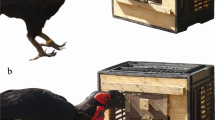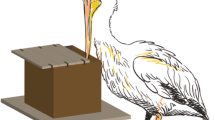Abstract
Wild chimpanzees commonly use sticks to fish for termites, ants or honey. This ability seems to be socially transmitted to juveniles by their mothers across generations. In a natural environment, the limited visibility of this behavior with regards to the extent of stick's insertion and about the success or failure in fishing hinders the study of the underlying learning processes.
This study explores the discovery and learning of tool use for fishing honey in an artificial hive by a group of four captive chimpanzees. The discovery of tool use was accidental and coactive. The speed with which the group of experimentally naive chimpanzees discovered and learned tool use suggests that wild chimpanzees of different populations independently discovered the fishing behavior. The alpha male and his ally learned before the subordinates. Here, trial-and-error learning was, as in monkeys, the main process allowing the acquisition of the tool-use technique. However, the observation of conspecifics allowed the orientation of the experimentation by the selection of clues. As suggested by Tomaselloet al. (1987). it is the understanding of the function of the tool,i.e. the cause-effect relations between the action of the demonstrator, the type of tool and the task to accomplish which confer to chimpanzees and advantage over monkeys.
Similar content being viewed by others
References
Beck B.B., 1974, Baboons, chimpanzees and tools,Journal of human evolution, 3: 509–516.
Beck B.B., 1975. Primate tool behavior. In R.H. Tuttle (Ed.)Socioecology of primates (pp. 413–447). Paris: Mouton Publishers, The Hague.
Beck B.B., 1978. Ontogeny of tool use by nonhuman animals. In G.M. Burghart and M. Bekoff (Eds),The development of behavior (chap. 20), New York and London: Garland STPM Press.
Beck B.B., 1980. Animal tool behavior. Garland Press, New York.
Boesch C. and Boesch H., 1990. Tool use and tool making in wild chimpanzees: 1. 54: 86–99.
Brewer S.M. and McGrew W.C., 1990. Chimpanzee use of a tool-set to get honey.Folia Primatol, 54: 100–104.
Chevalier-Skolnikoff S., 1989. Spontaneous tool use and sensorimotor intelligence in Cebus compared with other monkeys and apes.Behavioral and brain sciences, 12: 561–627
Doré F.Y., 1983.L'apprentissage: une approche psycho-éthologique. Chenelière et Stanké, Maloine Editeur.
Galef B.G. Jr., 1986. Tradition and social learning in animals, In: R.J. Hoage and L. Goldman (Eds),Animal Intelligence: insight into the animal mind (pp. 149–163). Washington and London: Smithsonian Institution Press.
Galef B.G. Jr., 1988. Imitation in animals: history,definitions, and interpretation of data from the psychological laboratory. In. T. Zentall & B.G. Galef (Eds.),Psychological and biological perspectives (pp. 1–28). Hillsdale, NJ: Erlbaum.
Hall, K.R.L., 1963. Observational learning in monkeys and apes.Brit. J. Psychol, 54(3): 201–226.
Kummer H. and Goodall J., (1985). Conditions of innovative behaviour in primates. In: L. Weiskrantz (Ed),Animal intelligence, Oxford psychology series (7) (pp. 203–214). Oxford: Clarendon Press.
Maki S., Alford P.L., Bloomsmith M.A., and Franklin J., 1989. Food puzzle device simulating termite fishing for captive Chimpanzees (Pan troglodytes).American Journal of Primatology Supplement 1: 71–78.
McGrew W.C., 1977. Socialization and object manipulation of wild chimpanzees. In S. Chevalier-Skolnikoff and F.E. Poirier (Eds),Primate bio-social development: biological, social and ecological determinants, (pp. 261–288). New York and London: Garland Publishing Inc.
McGrew W.C. and Collins D.A., 1985. Tool use by wild chimpanzees (Pan troglodytes) to obtain termites (Macrotermes herus) in the Mahale Mountains, Tanzania.American Journal of Primatology, 9: 47–62.
McGrew W.C. & Rogers M.E., 1983. Chimpanzees, tools, and termites: new record from Gabon.American Journal of Primatology, 5: 171–174.
McGrew W.C., Tutin C.E.G. & Baldwin P.J., 1979. Chimpanzees, tools, and termites: cross-cultural comparisons of Senegal, Tanzania and Rio Muni.Man, 14, 185–214.
Menzel E.W. Jr. (1963). The effects of cumulative experience in responses to novel objects in young isolation-reared chimpanzees.Behaviour, 21: 1–12.
Menzel E.W. Jr., 1971. Communication about the environment in a group of young chimpanzees.Folia Primat, 15, 220–232.
Menzel E.W. Jr., 1972. Spontaneous invention of ladders in a group of young chimpanzees.Folia Primat., 17: 87–106.
Menzel E.W. Jr., Davenport R.K. and Rogers Ch.M., 1970. The development of tool using in wild-born and restriction-reared chimpanzees.Folia primat., 12: 273–283.
Nishida T., 1987. Local traditions and cultural transmission. In B.B. Smuts, D.L. Cheney, R.M. Seyfarth, R.W. Wrangham & T.T. Struhsaker (Eds)Primates societies (pp 462–474). Chicago and London: University of Chicago Press.
Paquette D., 1980. Quelques aspects de l'ontogénie du comportement d'exploration chez deux chimpanzés. (Pan troglodytes). Mémoire de maîtrise, Université de Montréal.
Paquette, D., 1990. La dynamique des renversements du rang de dominance dans un groupe de chimpanzés adolescents en captivité. PhD thesis, Université de Montréal.
Paquette D. and Prescott J., 1988. Use of novel objects to enhance environments of captive chimpanzees.Zoo Biology, 7: 15–23.
Sumita K., Kitahara-Frisch J. & Norikoshi K., 1985. The acquisition of stone-tool use in captive chimpanzees.Primates, 26(2), 168–181.
Thorpe W.H., 1963.Learning and instinct in animals, Methuen, London.
Tomasello M., Davis-Dasilva M. and Camak L., 1987. Observational learning of tool-use by young chimpanzeesHuman evolution 2(2): 175–183.
van Lawick-Goodall, J., 1973. Cultural elements in a chimpanzee community. In E. Menzel (Ed), Precultural primate behavior, (pp. 144–184), New York: Karger.
Visalberghi E. and Trinca L., 1989. Tool use in captive monkeys: distinguishing between performing and understanding.Primates 30(4): 511–521.
Visalberghi E. and Fragaszy D.M. 1990.Do monkeys ape? in S.T. Parker and K.R. Gibson (Eds),“Language” and intelligence in monkeys and apes, (pp. 247–273), Cambridge University Press.
Whiten A., 1989. Transmission mechanisms in primate cultural evolution.Trends in ecology and evolution, 4(3): 61–62.
Yamagiwa J., Yumoto J.T., Ndunda M. and Maruhashi T., 1988. Evidence of tool-use by chimpanzees (Pan troglodytes schweinfurthii) for digging out a bee-nest in the Kahuzi-Biega National Park, Zaïre.Primates, 29(3): 405–411.
Author information
Authors and Affiliations
Rights and permissions
About this article
Cite this article
Paquette, D. Discovering and learning tool-use for fishing honey by captive chimpanzees. Hum. Evol. 7, 17–30 (1992). https://doi.org/10.1007/BF02436257
Issue Date:
DOI: https://doi.org/10.1007/BF02436257




